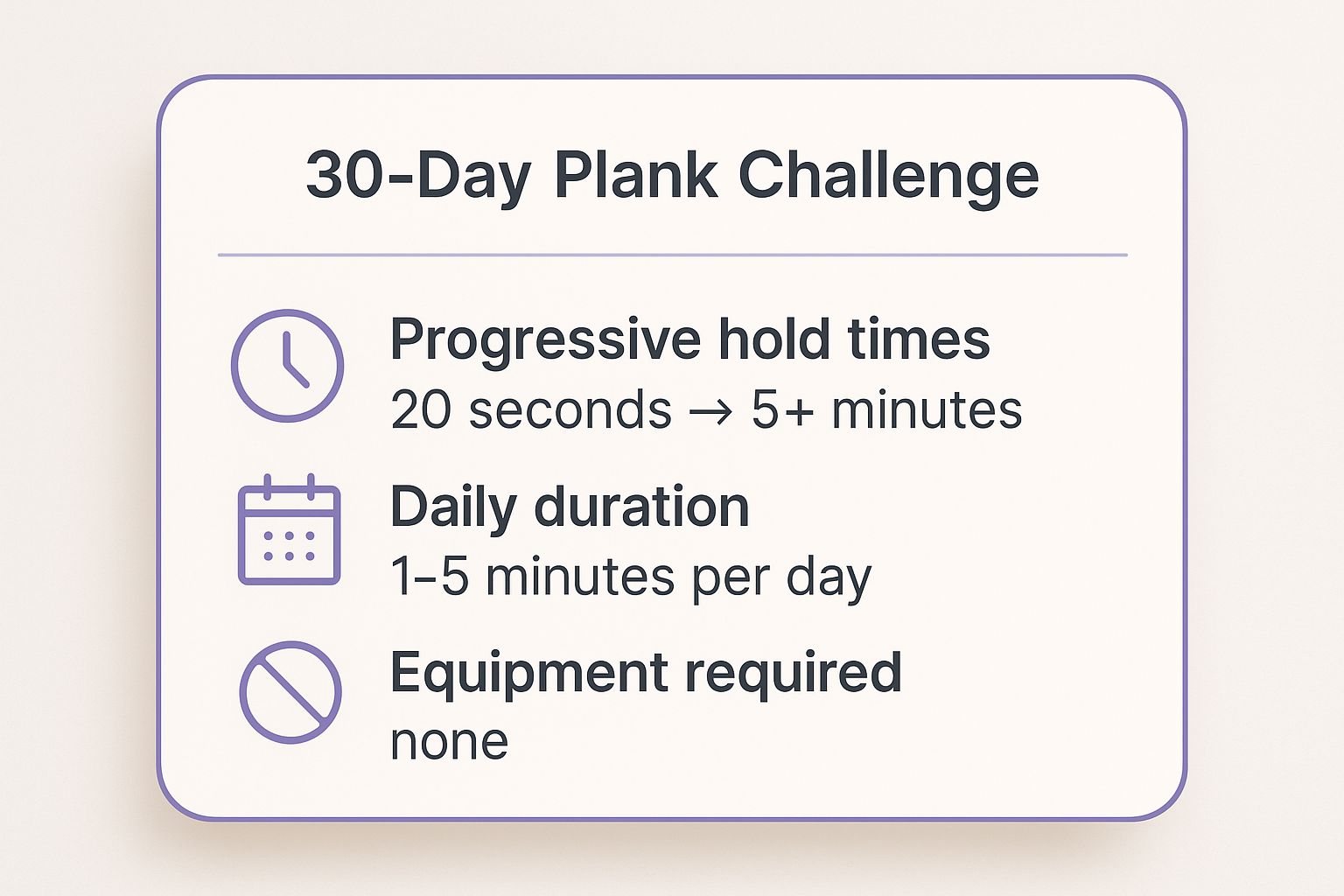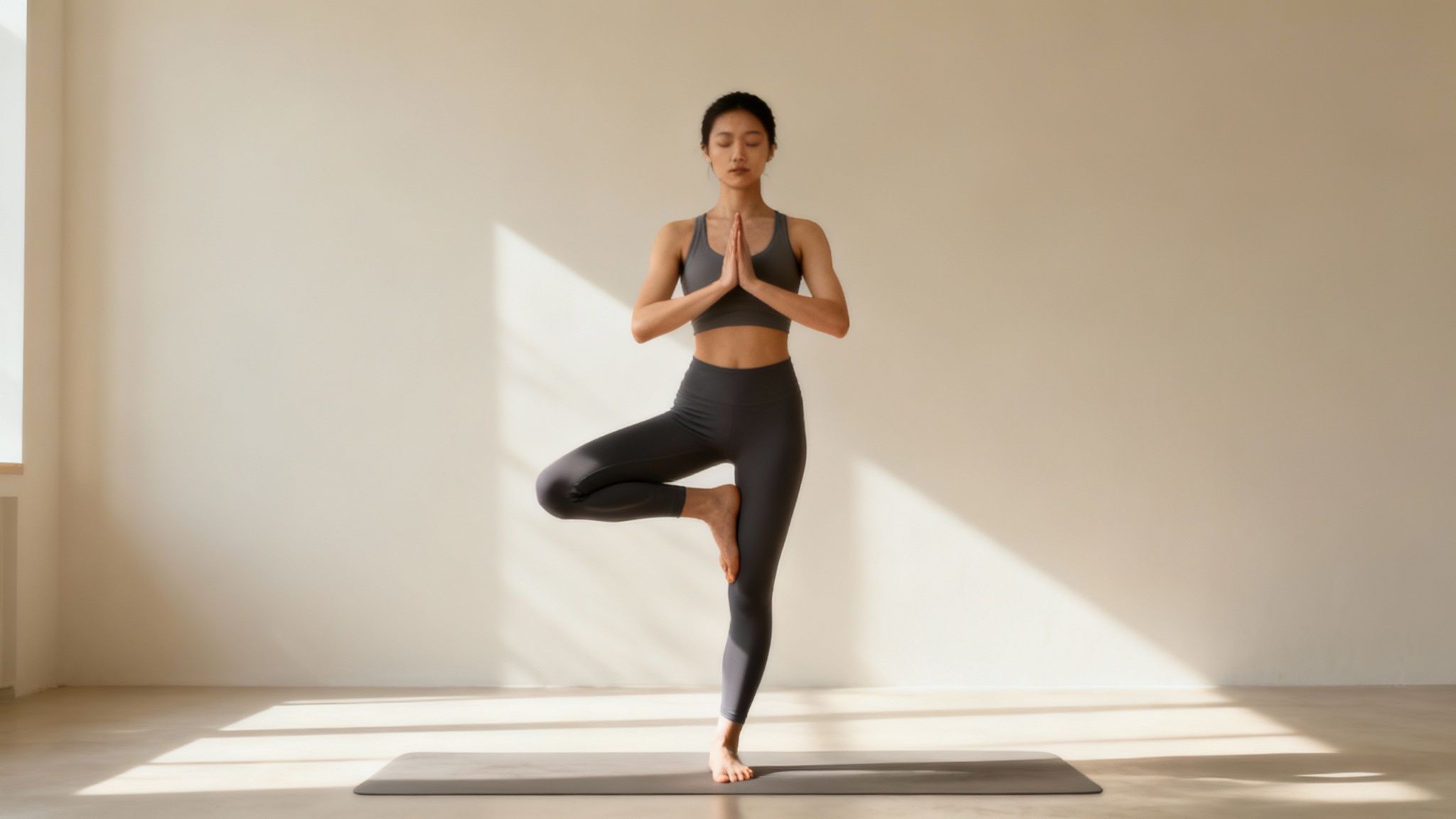

Discover 8 exciting monthly exercise challenges to boost your fitness. This guide offers plans for planks, squats, running, and more to keep you motivated.
Stuck in a fitness rut? The idea of a year-long commitment can be daunting, but a month? That's the perfect sweet spot for building momentum. Monthly exercise challenges offer a structured, achievable way to build new habits, break through plateaus, and inject some much-needed excitement into your routine. They provide a clear start and end date, fostering a sense of accomplishment that fuels long-term motivation. Completing a focused, 30-day goal not only delivers tangible physical results but also strengthens the mental discipline essential for any martial arts practice.
This guide explores 8 diverse monthly exercise challenges, from foundational core work to high-intensity cardio, that can transform your approach to fitness. Proper nutrition is just as crucial as the physical effort for seeing real progress. To support your body's recovery and muscle growth, you need adequate protein. For optimal performance and recovery during your monthly exercise challenges, explore these beneficial protein smoothie recipes.
Whether you're a seasoned martial artist looking to cross-train or a beginner aiming to build a solid base, there's a challenge here designed to push your limits. We'll break down the specific benefits, potential drawbacks, and expert implementation tips for each, so you can pick the perfect one to conquer next.
The 30-Day Plank Challenge is a progressive core-strengthening program designed to build endurance and stability over one month. It stands out as one of the most effective and accessible monthly exercise challenges because it requires no equipment and can be adapted for any fitness level. Participants start with short, manageable plank holds, typically 20-30 seconds, and incrementally increase the duration each day.
The ultimate goal is often to hold a continuous plank for three to five minutes, a significant test of core strength and mental fortitude. This gradual progression makes it an ideal challenge for martial arts students, as it builds the foundational core stability essential for powerful kicks, solid stances, and efficient rotational movements. The daily commitment also reinforces discipline and consistency, key tenets of martial arts training.
Integrating this challenge into your dojo is straightforward. You can run it as a standalone monthly event or incorporate it into the warm-up or cool-down portion of your classes.
For a quick reference, the following infographic summarizes the core components of the 30-Day Plank Challenge.

As the visualization highlights, the challenge's strength lies in its simplicity and progressive nature, making it a powerful tool that requires only consistency. This structure allows students of all ages and ranks to participate together, fostering a sense of community and shared achievement within your school.
The 10,000 Steps Daily Challenge is a month-long commitment focused on increasing overall physical activity by encouraging participants to walk at least 10,000 steps every day. This challenge promotes low-impact cardiovascular fitness and is an excellent way to build consistent, healthy habits. It is one of the most popular monthly exercise challenges because it requires minimal equipment-just a pedometer or smartphone-and can be seamlessly integrated into any lifestyle.
The goal is to hit the 10,000-step mark (roughly 5 miles or 8 kilometers) daily, fostering a consistent routine of movement. For martial arts students, this challenge builds cardiovascular endurance, aids in recovery between intense training sessions, and reinforces the discipline of daily practice. It's a fantastic way to improve overall health without adding high-intensity stress to the body, complementing rigorous dojo training with sustainable activity.
Launching a step challenge at your martial arts school can boost engagement and build community spirit outside of class time. It encourages students and their families to get active together.
The 100 Burpees a Day Challenge is an intense, high-volume program designed to dramatically boost cardiovascular endurance, full-body strength, and mental toughness. This demanding monthly exercise challenge involves performing 100 burpees every single day for 30 days. As a compound movement hitting the chest, shoulders, arms, core, and legs, the burpee is an incredibly efficient exercise for overall conditioning.

The goal is not necessarily to complete all 100 reps in one go, but to finish them within a 24-hour period. This structure builds immense grit and discipline, directly transferable to the martial arts mindset of pushing through physical and mental barriers. The explosive nature of the burpee also enhances power and agility, which are critical attributes for sparring, grappling, and dynamic forms. It is one of the most transformative monthly exercise challenges for dedicated students.
This challenge is best suited for intermediate to advanced students due to its high intensity. However, modifications can make it accessible to a wider audience.
For a quick reference, the following infographic summarizes the core components of the 100 Burpees a Day Challenge.
The challenge's power lies in its simplicity and sheer volume. It requires no equipment, only space and determination. By encouraging students to track their completion times or sets, you create a tangible measure of their progress in conditioning and work capacity over the month. This fosters a profound sense of accomplishment and resilience.
The Squat Challenge is a lower-body focused program designed to dramatically increase leg strength and endurance over a 30-day period. This is one of the most popular monthly exercise challenges because it targets the body's largest muscle groups, delivering significant functional fitness gains with just one bodyweight movement. Participants start with a manageable number of squats, such as 50, and progressively increase the repetitions daily, aiming to complete 250 or more in a single session by the end of the month.
The ultimate goal is to build powerful legs and a solid base, which is crucial for martial arts practitioners. Stronger legs translate directly to more explosive kicks, deeper stances, and improved balance. This progressive overload model also builds mental toughness, teaching students to push through discomfort and commit to a demanding goal, mirroring the discipline required to advance in rank. The challenge is highly scalable and requires no equipment, making it a perfect fit for any dojo environment.
You can introduce this challenge as a monthly school-wide event to boost engagement and build camaraderie. It works well as a group activity before or after class, creating a shared sense of accomplishment.
The Yoga Every Day Challenge is a 30-day commitment to a consistent yoga practice, with daily sessions typically lasting from 15 to 60 minutes. This popular monthly exercise challenge focuses on improving flexibility, balance, and mindfulness through a combination of physical postures (asanas), breathing techniques (pranayama), and meditation. Participants often follow structured online programs, such as Yoga with Adriene's "30 Days of Yoga," which guide them through a progressive journey.

This challenge is exceptionally beneficial for martial arts students as it directly enhances the mind-body connection crucial for advanced techniques. Regular practice improves joint mobility for higher kicks, core stability for powerful strikes, and mental focus for sparring and forms. The emphasis on breath control also translates directly to managing energy and staying calm under pressure, making it one of the most complementary monthly exercise challenges for any martial discipline.
You can encourage students to follow a popular online program at home or host dedicated short sessions before or after class. The key is promoting consistency over intensity.
The Running Streak Challenge is a demanding test of commitment where participants run at least one mile every single day for a month. This challenge is less about speed or distance and more about building unshakable discipline, mental toughness, and cardiovascular consistency. It requires participants to run regardless of weather, their schedule, or how they feel, making it an exceptional tool for forging resilience.
For martial arts students, the benefits are profound. The daily act of lacing up shoes and hitting the pavement, even when unmotivated, directly translates to the discipline required to show up for class and push through difficult training sessions. This type of monthly exercise challenge builds a robust aerobic base, improving stamina for sparring, forms, and conditioning drills, ultimately leading to better performance and faster recovery.
You can introduce this challenge to students as a personal development goal that complements their martial arts training. It can be tracked individually or as a collective school effort to build camaraderie.
The Pull-Up Progression Challenge is a structured, 30-day program designed to develop the specific strength required to perform one of the most functional upper-body exercises. It's one of the most rewarding monthly exercise challenges because it guides participants from foundational movements to achieving their first full pull-up or increasing their maximum repetitions. The challenge methodically builds back, bicep, and grip strength through a combination of negative pull-ups, assisted variations, dead hangs, and scapular pulls.

The ultimate goal is tangible and highly motivating: conquering the pull-up. For martial arts, this translates directly into enhanced grappling strength, powerful clinching, and improved ability to control an opponent. The daily focus on progressive overload builds not just physical power but also the grit and perseverance necessary for advancing in rank. This challenge is excellent for illustrating how breaking down a complex goal into manageable daily steps leads to significant achievement.
This challenge requires access to a pull-up bar but can be adapted for various strength levels, making it inclusive for most students. It's an excellent way to introduce structured strength training.
The following video from calisthenics expert Chris Heria provides an excellent visual guide to the exercises and progressions involved.
By providing a clear, step-by-step path to a difficult skill, you empower your students and give them a visible benchmark of their increasing strength. This fosters a powerful sense of accomplishment that can boost their confidence both inside and outside the dojo.
The HIIT 20-Minute Daily Challenge is a high-impact, time-efficient program designed to boost cardiovascular fitness and metabolic rate over one month. Participants commit to a 20-minute High-Intensity Interval Training (HIIT) session each day, alternating short bursts of all-out effort with brief recovery periods. This method maximizes results in minimal time, making it one of the most practical monthly exercise challenges for busy individuals.
The core principle involves pushing your physical limits for intervals ranging from 20 to 45 seconds, followed by 10 to 30 seconds of rest or low-intensity movement. This cycle is repeated with exercises like burpees, high knees, and mountain climbers. For martial arts students, this challenge directly improves anaerobic endurance, which is crucial for explosive combinations, rapid footwork, and maintaining intensity through multiple rounds of sparring.
This challenge is an excellent way to boost your students' conditioning and can be easily adapted for group settings. It can serve as a potent finisher at the end of class or as a standalone community event.
Completing any of the monthly exercise challenges detailed in this guide, from the core-shredding 30-Day Plank Challenge to the relentless Burpee Challenge, is a monumental achievement. It's a testament not just to your students' physical endurance but to their mental fortitude and commitment. You have provided them with a structured path to success, and they have walked it for 30 consecutive days. The critical question now is: what happens on day 31?
The true value of a 30-day challenge isn't just the finish line; it's the momentum it generates. The end of one challenge should be the starting block for the next phase of a student's fitness journey. This is where your role as an instructor becomes even more vital. Help your students transition from a temporary goal to a sustainable, lifelong habit.
The immediate aftermath of a successful challenge is a powerful window of opportunity. Your students are likely feeling stronger, more confident, and more attuned to their bodies. Capitalize on this by guiding them through a process of reflection and future planning.
Encourage them to consider a few key questions:
Their answers are the blueprint for their long-term success. A student who loved the progressive nature of the Squat Challenge might be a perfect candidate for a structured strength training program. Someone who thrived on the community aspect of the 10,000 Steps Challenge would benefit from joining a group class or finding a dedicated training partner within your school.
For you, the school owner, these monthly exercise challenges are more than just fitness add-ons; they are powerful tools for community building and student retention. By facilitating these events, you create shared experiences that forge strong bonds between members. Celebrating daily wins and milestone achievements, whether in person or through your school's communication channels, makes every student feel seen and valued. This sense of belonging is precisely what transforms a customer into a loyal member of your dojo's community.
The key is to keep the energy going. Don't let the excitement fade after one challenge ends.
The ultimate goal is to reframe fitness not as a temporary, month-long sprint but as an integral, enjoyable part of the martial arts lifestyle. By consistently offering engaging and well-managed monthly exercise challenges, you empower your students to build a foundation for a healthier, more active life while simultaneously strengthening the very fabric of your school.
Ready to supercharge student engagement and streamline your next challenge? Martialytics provides the all-in-one platform to communicate daily goals, track student progress, and celebrate wins effortlessly. See how our powerful tools can turn your next monthly exercise challenge into your best retention driver by visiting Martialytics today.


No credit card required. No lock in contracts. Start your 30-day free trial to see immediate improvements.

Book your free demo with one of the co-founders of Martialytics, Brad or Allen, depending on your time-zone.
We'll do this on Zoom video conferencing software for awesome screen sharing so please make sure you have the app or are good to go before the time starts.